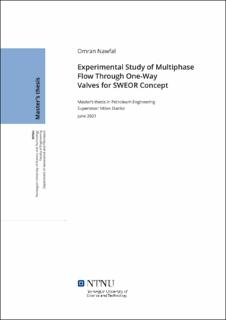| dc.description.abstract | This thesis studies the efficiency of conical seat one-way ball-type valves, and the possibility
of their usage in the frac-to-frac method in tight oil reservoirs through the single well enhanced
oil recovery method. Thus, an injection valve that only allows flow from the tubing into the
formation and a production valve that only allows flow from the formation into the tubing are
tested to understand their performance by measure their leakages and rates needed to become
functional.
The experimental work was conducted using two test benches, a high-pressure (HP) test bench
that was used to measure the leakage rates and closing rates of the valves, and a low-pressure
(LP) test bench that allows to visualize the flow and measure and calculate the leakage through
the valves. This second low-pressure test bench is useful to propose design improvements. The
fluids used during these experiments were air and water, and the results were extracted through
the Labview software.
In the experiments using the HP test bench, the valves had a Silicon Nitride ball with a hex-hole lid that keeps the ball in place. In addition, thread seal tape was used to decrease possible
leakage through the threading (between the valve body and the cell wall). Leakage rate tests
were done at 50, 75, 100, 125, and 150 bar pressure difference. The tests’ durations varied
between forty minutes and two hours. The results showed an increase in the leakage rate as the
pressure was increased. The coefficient of variation of the leakage rates during the stabilization
period was high for low leakage rates and were very low, for high leakage rates.
Closing rate tests were performed in the HP test bench to determine the flow rate needed for
the ball to be pushed into place, shutting the valve closed. Two closing rate tests were done for
each valve and the average of the values obtained is reported.
Leakage tests in the HP test bench were conducted on an injection and a production blind, to
quantify the leakage through the threading. The values obtained were then compared against
the results with the valves to back-calculate the leakage through the seal surface between the
conus and the ball. One peculiar result is that he leakage through the production blind was
higher than through the production valve; however, as the leakage rates were very low, it is
believed that this may be caused by the thread seal tape that was applied differently in both
tests.
Regarding the LP transparent test bench, two types of experiments were conducted, an air-injection water-production cyclic experiment, and an air-injection zero-production cyclic
experiment. In the first one, when injection starts, the air rate that causes the closing of the
production valve is determined by visual inspection and subsequent check of the measurement
loggings. The injection phase then continues until the tank reaches maximum possible pressure.
Then, the production phase begins, water is sent through the production valve. During this
phase, the air tank will depressurize, due to leakage of air through the injection valve. The
leakage rate appeared (visually) to be higher when water production took place after the air
injection phase, compared to when the tank leakage through the valve was left to take place by
itself. It is believed that this is because in the first case the pressure differential across the valve
is lower than for the second case. These tests allowed to visualize the leakage through the
valves and understand the nature of the flow within the cell.
After performing the experiments, the valves showed very positive results, having minimal
leakage rates compared to the seal thresholds set by NORSOK (0.4 liters/min for water and 15
scfm for gas), proving that the current valves’ designs could qualify as a barrier between the
formation and the rest of the production system.
Finally, the aim of this work is to provide a completion technology that is simple and cost-effective for usage in the single well enhanced oil recovery through the frac-to-frac method in
tight oil reservoirs, which allegedly has a better performance than the Huff-n-Puff method. | |
